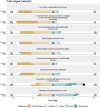Gender differences in structural and attitudinal barriers to mental healthcare in UK Armed Forces personnel and veterans with self-reported mental health problems
- PMID: 37855900
- PMCID: PMC11087310
- DOI: 10.1007/s00127-023-02567-0
Gender differences in structural and attitudinal barriers to mental healthcare in UK Armed Forces personnel and veterans with self-reported mental health problems
Abstract
Purpose: Structural and attitudinal barriers often hinder treatment-seeking for mental health problems among members of the Armed Forces. However, little is known about potential gender differences in structural and attitudinal barriers among members of the UK Armed Forces. The current study aimed to explore how men and women differ in terms of these barriers to care among a sample of UK Armed Forces personnel and veterans with self-reported mental health problems.
Methods: Currently serving and ex-serving members of the UK Armed Forces who self-reported a mental health problem were invited to participate in a semi-structured phone interview on mental health and treatment-seeking. The final sample included 1448 participants (1229 men and 219 women). All participants reported on their current mental health, public stigma, self-stigma, and barriers to mental healthcare.
Results: Overall, men and women reported similar levels of both structural and attitudinal barriers, with no significant differences detected. The highest scores for both men and women were observed in attitudinal barriers relating to self-stigma domains, which encapsulate internalised attitudes and beliefs about mental illness and treatment.
Conclusions: Findings suggest that anti-stigma campaigns can be targeted simultaneously at both men and women within the Armed Forces. In particular, targeting self-stigma may be beneficial for health promotion campaigns.
Keywords: Barriers to care; Gender differences; Mental health problems; Military personnel; Stigma.
© 2023. The Author(s).
Conflict of interest statement
A.M. is funded by The Colt Foundation. The views expressed are those of the author(s) and not necessarily those of The Colt Foundation. NG runs March on Stress Ltd which is a psychological health consultancy that provides some mental health training interventions for UK police forces. He is also the Royal College of Psychiatrists lead for trauma and the military. NTF reports grants from the UK MoD and Office for Veterans’ Affairs (Cabinet Office), is a trustee (unpaid) of Help for Heroes, is a member of the Emergency Responders Senior Leaders Board, the Gallipoli Medical Research Foundation, and is an independent advisor to the Independent Group Advising NHS Digital on the Release of patient Data (IGARD). S.A.M. Stevelink is supported by the National Institute for Health and Care Research (NIHR) Maudsley Biomedical Research Centre at South London and Maudsley NHS Foundation Trust and the National Institute for Health and Care Research, NIHR Advanced Fellowship, Dr Sharon Stevelink, NIHR300592.
Figures




Similar articles
-
Perceived stigma and barriers to care in UK Armed Forces personnel and veterans with and without probable mental disorders.BMC Psychol. 2019 Nov 27;7(1):75. doi: 10.1186/s40359-019-0351-7. BMC Psychol. 2019. PMID: 31775853 Free PMC article.
-
Mental Health, Help-Seeking Behaviour and Social Support in the UK Armed Forces by Gender.Psychiatry. 2019 Fall;82(3):256-271. doi: 10.1080/00332747.2019.1626200. Epub 2019 Aug 6. Psychiatry. 2019. PMID: 31385751
-
PTSD, stigma and barriers to help-seeking within the UK Armed Forces.J R Army Med Corps. 2015 Dec;161(4):322-6. doi: 10.1136/jramc-2014-000344. Epub 2014 Dec 18. J R Army Med Corps. 2015. PMID: 25525202 Review.
-
Do stigma and other perceived barriers to mental health care differ across Armed Forces?J R Soc Med. 2010 Apr;103(4):148-56. doi: 10.1258/jrsm.2010.090426. J R Soc Med. 2010. PMID: 20382906 Free PMC article.
-
Veteran help-seeking behaviour for mental health issues: a systematic review.BMJ Mil Health. 2022 Feb;168(1):99-104. doi: 10.1136/bmjmilitary-2021-001903. Epub 2021 Jul 12. BMJ Mil Health. 2022. PMID: 34253643
References
-
- Link BG and Phelan JC (2001) Conceptualizing Stigma. Annu Rev Sociol 27:363–385. Available: http://www.jstor.org/stable/2678626
Publication types
MeSH terms
Grants and funding
LinkOut - more resources
Full Text Sources
Medical

